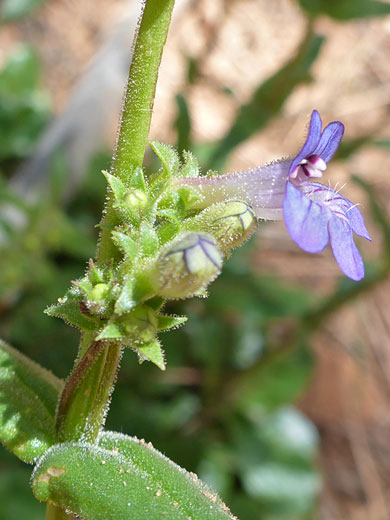Common names:
Low beardtongue, Zion penstemon
Family:
Scientific name:
Penstemon humilis
Main flower color:
Range:
All states west of the Rocky Mountains, except Arizona and New Mexico
Height:
Up to 12 inches
Habitat:
Sagebrush, woodland, rocky hillsides, from 5,000 to 10,000 feet
Leaves:
Opposite, lanceolate to ovate, up to 2 inches long
Season:
April to August
Flowers of penstemon humilis are produced in small numbers, in whorls at the upper leaf nodes; they are relatively small, around half an inch long, with white throats and blue-purple lobes, crossed by a few lengthwise, darker purple veins. The four stamens are slightly exserted below the two lobes of the upper lip; they have curved white filaments and large, pinkish, two-lobed anthers. The staminode is shorter, positioned below the middle lobe of the lower lip, and has a covering of yellow to orange hairs. A few longer white hairs are attached to the inside of the lower lip, while the outside of the corolla is sparsely covered by short, glandular hairs.
Leaves grow mostly at the base, attached by short stalks, but also at widely-spaced intervals along the stem, where they are sessile, and clasping.
There are three subspecies of penstemon humilis. Least common is ssp obtusifolius (Zion penstemon), found only in southeast Utah; this has generally hairless basal leaves, and cauline leaves that are often minutely toothed. Ssp brevifolius of north Utah has hairless basal leaves and entire cauline leaves, while the most widespread ssp humilis has hairy basal leaves, and slightly larger flowers.
Leaves grow mostly at the base, attached by short stalks, but also at widely-spaced intervals along the stem, where they are sessile, and clasping.
There are three subspecies of penstemon humilis. Least common is ssp obtusifolius (Zion penstemon), found only in southeast Utah; this has generally hairless basal leaves, and cauline leaves that are often minutely toothed. Ssp brevifolius of north Utah has hairless basal leaves and entire cauline leaves, while the most widespread ssp humilis has hairy basal leaves, and slightly larger flowers.
All Contents © Copyright The American Southwest | Comments and Questions | Contribute | Site Map




